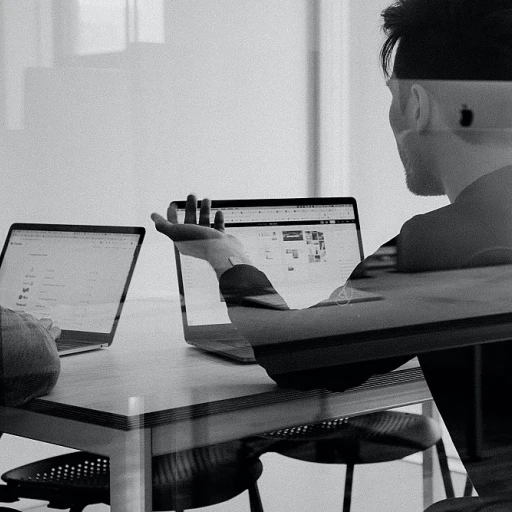
Understanding Well-Being in the Workplace
Defining the Core of Well-Being
Understanding well-being in the workplace requires a thorough look at various aspects of an employee's life at work and beyond. It's not merely the absence of illness or stress, but a comprehensive state involving health, happiness, and satisfaction with one's job and work environment. The nuances of this concept include physical health, mental health, job satisfaction, and social support among other elements.Components of Workplace Well-Being
The multi-faceted nature of well-being encompasses various dimensions, including:- Physical Health: Good physical health reduces absenteeism and fosters productivity. Working conditions and work design often play a vital role in maintaining physical well-being.
- Mental Health: Mental well-being is a crucial aspect with the power to affect job performance and satisfaction. The effects of stress and work interference play significant roles here.
- Social Support: A supportive work environment that allows social interactions and fosters job autonomy greatly contributes to overall employee well-being.
- Work-Life Balance: This includes the balance employees maintain between their work demands and personal life, which has been highlighted in context to remote working.
The Role of Occupational Health
Occupational health plays a pivotal role in ensuring employees' physical and mental well-being. By addressing various aspects like working conditions and employee support, organizations can tackle the occupational health challenges that may arise, specifically during remote work scenarios. For those interested in how these various elements impact workforce metrics, learn about the impact of outboarding on workforce analytics.Remote Work: A New Paradigm
Embracing Remote Work as a Modern Approach
The transition to remote work has brought about a significant shift in how organizations function and how employees perform their duties. This new paradigm offers both opportunities and challenges in terms of well-being, social connection, and productivity. The effects of remote working extend beyond the boundaries of traditional workplace settings, impacting mental and physical health, job satisfaction, and overall employee well-being. Remote work allows employees greater job autonomy, enabling them to design their working conditions to better fit personal and family responsibilities. This autonomy can lead to increased job satisfaction and a healthier work-life balance. However, it also demands a high degree of self-motivation and time management skills, which can sometimes lead to stress and work interference. Social support plays a critical role in mitigating the mental health effects associated with working remotely. During the COVID pandemic, the lack of in-person social interactions has highlighted the importance of virtual communication tools and strategies within organizations. Remote workers can experience a sense of isolation, which can negatively affect their well-being if not carefully managed. As organizations embrace telework, understanding the interplay between remote working conditions and employee well-being becomes crucial. It's essential to recognize the importance of insightful vs active tracking in HR analytics to effectively measure and support the mental and social health needs of employees. Such tracking allows Human Resources to proactively address potential stressors and provide the necessary social support before they become significant challenges. Studies accessed through platforms like Google Scholar and relevant psychology DOI articles suggest that thoughtfully designed job roles, consistent virtual feedback, and employee support systems are paramount to promoting a positive remote work experience. As organizations continue to navigate this new landscape, they must prioritize the well-being of their remote workers to ensure both organizational success and the health of their workforce.Theories Linking Well-Being and Remote Work
The Interplay Between Well-Being Theories and Remote Work
Remote working has gained significant attention, especially during the covid pandemic. As employees adapt to this new paradigm, understanding the theories that link well-being and remote work becomes crucial for organizations. Several theories from the fields of psychology and occupational health can help us comprehend the effects of remote work on employee well-being. One such theory is the Job Demands-Resources (JD-R) model, which emphasizes the balance between job demands and resources. In a remote work context, job demands might include work interference with family life and increased stress due to blurred boundaries between personal and professional spheres. However, these can be mitigated by enhancing job resources such as social support and job autonomy. Job autonomy, as a psychological concept, plays a vital role in employee well-being while teleworking. Having control over one's tasks and schedules allows remote workers to better manage their time, ultimately leading to improved work-life balance and job satisfaction. Moreover, Emotional Labor Theory suggests that the emotional regulation required in remote jobs can impact mental health and overall well-being. Unlike traditional office settings, remote employees often face challenges due to the lack of face-to-face interactions, impacting their social health. Employers must ensure that employees have access to appropriate social support systems to prevent isolation and promote a healthy work-life culture. Finally, the Social Exchange Theory posits that reciprocal relationships between employers and employees significantly affect well-being. In a remote work set-up, ensuring that employees feel valued and supported can boost their emotional and mental health, leading to higher levels of satisfaction and productivity. The combined application of these theories, along with an effective review of working conditions, is crucial for organizations that aim to support remote employee well-being. HR analytics can play a pivotal role in measuring and enhancing these aspects effectively. For further insights on enhancing HR communication through analytics, visit this resource.Human Resources Analytics: Measuring Well-Being
Quantifying Workforce Well-Being in a Remote Context
Human Resources (HR) analytics is pivotal in evaluating well-being in the workplace, especially as remote work becomes more prevalent. The intersection of employee well-being and remote working conditions presents a complex dynamic that necessitates precise measurement and analysis. Understanding and measuring the effects of telework on employee well-being involves assessing numerous factors:- Mental Health and Stress Levels: The mental health of employees can be significantly impacted by remote work setups. HR analytics tools can track metrics like perceived stress levels and mental fatigue by conducting employee surveys and health assessments over time.
- Physical Health and Ergonomics: Working conditions at home are vastly different from traditional office settings. Analyzing ergonomic factors through data collected from employees can highlight physical health issues due to prolonged sitting or inadequate office furniture at home, which play into overall well-being.
- Job Satisfaction and Autonomy: Research, including insights from platforms like Google Scholar, emphasizes the relationship between job satisfaction and job autonomy. Remote workers often report increased job autonomy, potentially impacting their satisfaction levels. HR analytics can assess these shifts through feedback and performance reviews.
- Work-Life Balance and Interference: Remote work blurs the lines between professional and personal time, which can affect employee social and family life. HR metrics can evaluate work interference with family time by monitoring work hours against productivity measures.
- Social Support and Connectivity: Maintaining connections while working remotely can be challenging, impacting social health. Surveys focusing on employee perceptions of peer support and connectivity can be valuable sources of data, aiding in crafting strategies for enhanced social support systems.
- Impact of COVID Pandemic: The long-term effects of the COVID pandemic on remote workers' well-being continue to be a critical area of focus. Analyzing trends pre- and post-pandemic through HR analytics provides valuable insights into the changing landscape of mental and physical health concerns.
Challenges in Analyzing Remote Work Well-Being
The Complexity of Measuring Remote Work Well-Being
Analyzing the well-being of remote workers presents unique challenges, particularly in the aftermath of the COVID pandemic. The shift to remote working has altered traditional workplace metrics. With job autonomy becoming more prevalent, employees now face a blend of personal and professional responsibilities, often leading to work-family conflict and increased stress levels.
A significant hurdle in measuring well-being is the lack of direct oversight, which requires reliance on self-reported data. This data may include metrics on mental health, social support, and job satisfaction. The variability in working conditions, such as the differences in home office setups, further complicates the assessment of occupational health.
Data Sources and Analytical Methods
To derive meaningful insights on remote employee well-being, organizations often use a combination of surveys, performance reviews, and psychological assessments. Platforms like Google Scholar offer academic resources on work design and the impacts of remote work on mental health. These sources provide valuable insights that inform analysis but may not fully capture the reality of employee experiences due to biases and subjective reporting.
Balancing Qualitative and Quantitative Data
Balancing qualitative data, such as employee interviews, with quantitative metrics such as productivity and absenteeism rates, is crucial. This approach helps HR professionals understand the nuanced effects of telework on well-being beyond simplistic measurements.
Ultimately, human resources analytics must continuously evolve to accurately reflect the current state of remote work life and its implications on employee health and satisfaction. By addressing these challenges, HR leaders can better support job engagement and mitigate the negative effects that remote working might have on employees.
Future Trends in Well-Being and Remote Work
Adapting to the Evolving Work Landscape
The future of well-being and remote work is a dynamic space that continues to morph in response to various factors. The COVID pandemic has accelerated the shift towards telework, highlighting the importance of understanding its effects on employee well-being. Moving forward, organizations must navigate the complexities of these changes.
Emphasizing Flexibility and Support
Flexibility will remain a cornerstone of remote work. Companies are exploring ways to provide better job autonomy and tailor work conditions to individual needs. As remote workers continue to face challenges like work interference with family life, offering comprehensive social support is critical.
With the rise in mental health awareness, businesses are increasingly focusing on psychological health. Employers will need to invest in programs that support mental well-being, helping employees manage stress and maintain a healthy work-life balance.
Leveraging Analytics for Enhanced Insights
Leveraging human resources analytics will play a vital role in addressing both existing and future challenges of remote work. Businesses are using analytics to monitor employee well-being, identifying trends, and tailoring interventions. Platforms like Google Scholar offer valuable insights into the latest research and developments.
Emerging analytics technologies are enhancing our understanding of the interplay between remote work and well-being. This, in turn, aids in creating optimal work environments that support employee job satisfaction and overall occupational health.
Potential Challenges and Opportunities
The journey to improving remote work well-being is not without its challenges. Organizations must strive to mitigate potential issues such as the isolation of remote workers, which can affect both social and mental health. As remote work becomes mainstream, the focus on maintaining robust social connections is critical to nurturing a healthy workplace culture.
Meanwhile, opportunities abound. By combining insights from workplace health reviews with innovative work design, companies can achieve a thriving, resilient workforce. As we continue to adapt and evolve, the commitment to addressing and enhancing employee well-being in our remote work culture remains pivotal.












